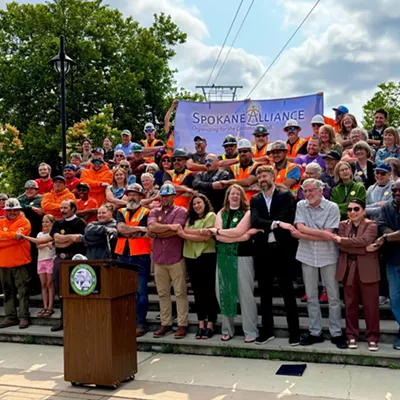Until recently, Thin Air Community Radio may have been the best thing happening in Spokane that nobody knew about. Think about it: a truly independent radio station in the wasteland of corporate broadcasting; it's a grab bag of music and programming more eclectic than anything the Inland Northwest has heard for too long, and pulling it all off with charming leftist appeal.
But the chances are that all you've heard at 95.3 is a faint static buzz. That's because until mid-December, KYRS Thin Air Radio had only a 100-watt transmitter (that's the power of most home light bulbs) on an antenna 11 miles south of downtown Spokane. A few lucky listeners on the South Hill and elsewhere got to enjoy the station's 27 live shows, but the rest of the city was left in the dark.
That all started to change on Dec. 1, however, when the Peace and Justice Action League of Spokane (PJALS) got their hands on a translator just north of downtown. Though the translator runs on only half the wattage of the transmitter south of town, its height and proximity to Spokane means that it provides far broader and uniform coverage. As of Dec. 12, the translator now picks up the 95.3 signal from south of the city and spreads the love on 92.3 for tens of miles in every direction.
That alone, suggests KYRS station manager Lupito Flores - the fact that Thin Air can now be heard by as many as 300,000 people from as far away as Fishtrap and Newport -- calls for a party.
But it's not just the new translator that's got Thin Air radioheads worked up. Last week, the station also adopted a new broadcast protocol, ditching a process that involved bouncing signals from the station to a satellite to the transmitter to the translator, for a simpler protocol originating at a microwave dish on the station's roof. Flores and Thin Air board president Jon Snyder say that the dish should not only push the signal even further out, but that it should also solve a problem that's plagued the station from the start: sudden, sometimes frequent, interruptions in the broadcast, caused by burps in the DSL system.
They also report that this weekend they will begin broadcasting exclusively in stereo -- which, of course, means better, more faithful sound. It also means that the seek function on car radio -- which hunts out stereo signals specifically -- will likely no longer pass KYRS by on its way through the dial from stale classic rock to irate conservative talk.
After all, that is what Lupito Flores suggests Thin Air is essentially all about -- providing new, diverse, local voices. "More and more, large corporations are gobbling up the public airwaves and playing the same homogenized [material]," he says. "It's critical that people are able to hear diverse voices, not just what the corporations want you to hear. There are a lot of unheard voices in Spokane that we want people to hear."
To that end, KYRS has put together a remarkably diverse schedule, with programs like the Persian Hour, Radio Russia and Los Caminos de la Vida. "There are 20,000 Russian refugees in Spokane," says Flores. "But you wouldn't know it from the evening radio." Pile on shows like Pagan Uprising!, Queer Sounds and Free Speech Radio News, and you might begin to understand why Flores is so proud to have achieved his dreams of diverse radio -- and why Thin Air has struggled every step of the way.
"It's bizarre how the government is making it so difficult for small stations to stay on the air," he says, adding that growing the station meant jumping through some "amazing technical and legal hoops." At a time when many in the country resorted to pirating others' airwaves just to get heard, Flores, Snyder and others worked to make Thin Air legit.
"We wanted to make this last and do it right and do it legally," says Flores. He and other supporters jumped on an initiative created by former Federal Communications Commission chairman William Kennard in 2000, which provided space on the airwaves for nonprofit, community-minded groups to create low-powered FM (LPFM) stations.
The initiative was met with considerable antagonism, however, by the National Association of Broadcasters and National Public Radio, which worried that LPFM stations would interrupt pre-existing signals (an idea the FCC would later disprove). The result was a series of restrictions to the initiative, including a stipulation that LPFMs had to broadcast on a frequency four clicks away from pre-existing commercial stations on the dial, in either direction. The stipulation took the wind out of thousands of LPFM applications, but Thin Air got lucky. At 95.3 they found the only such spot on Spokane's dial.
Now, with more than a year of local radio under its belt and a new, microwave-backed, stereo-blasting translator blanketing the region in indie pop, lefty news and Latin lounge, Thin Air Radio can finally let its hair down and celebrate.
You're coming through loud and clear.
End transmission.



















